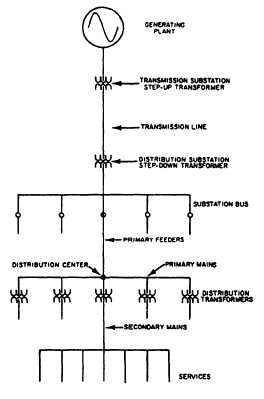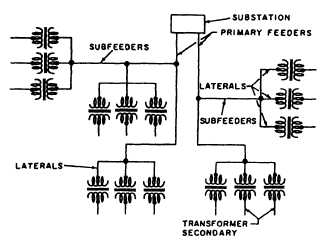system that includes both the transmission and
distribution systems. To explain the two systems, we
will begin with the transmission system.
TRANSMISSION SYSTEM
Refering to figure 2-1, you will see that the starting
point for electrical power is its place of generation, or
generating station, which uses fossil fuels, water
pressure, or, in some locations, nuclear energy to drive
turbine generators. The energy generated in these
stations is generally in the range of 13,200 to 24,000
volts. That voltage is insufficient for economical
transmission over long distances. Therefore, the voltage
is raised to transmission levels of 138,000 to 765,000
volts at a transmission substation located at the
generating station. A substation is a facility that contains
transformers, switches, and other equipment that is used
to raise or lower voltages to transmission or distribution
levels and to protect the substation and the transmission
lines or distribution feeders against faults.
Sets of conductors that are energized with high
voltage and transmit large bulks of power over relatively
long distances are known as transmission lines or
transmission circuits. Usually, these circuits are run
overhead with structures supporting the conductors,
which are attached to insulators. In some locations
where it is not practical or permissible to have overhead
high-voltage lines, the transmission lines may be run
underground. The transmission lines shown in figure
2-1 are overhead and supported by towers.
As shown in the figure, the transmission lines, or
circuits, deliver power from the transmission sub-
station located at the generating plant to customers
located along the route. Where required throughout its
length, transmission circuits are equipped with
additional transmission substations that lower the
voltage to reduced transmission (or subtransmission)
levels. The transmission circuits are also equipped with
distribution substations that reduce the voltage to
required distribution levels. It is at the distribution
substations that the distribution system begins.
DISTRIBUTION SYSTEM
The distribution system is that portion of the
electrical power system that connects the transmission
system to the user’s equipment. It includes distribution
substations, feeder circuits, distribution centers,
primary mains, distribution transformers, protective
devices, secondary circuits, and services. Figure 2-2
shows the principal elements of a distribution system.
A power distribution system may be either an
overhead distribution line or an underground cable
Figure 2-2.—Elements of a power distribution system.
Figure 2-3.—Radial distribution system.
system. Since it is less costly to construct, the overhead
system is more common. However, in some instances,
such as near an airfield, an underground system may be
required. This chapter will discuss mainly the overhead
distribution system.
Substations
The distribution substation transforms the trans-
mission voltage to the proper distribution voltage levels
and protects the substation and transmission lines
against faults occurring in the feeder circuits. At
advanced bases, the source of power may be generators
2-2



